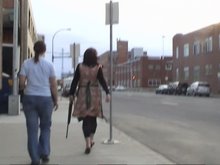
The Beespeaker Project by Lori Weidenhammer
Video Still: Tagny Duff
The urban planning of Edmonton has noticeably reduced allocation of green space in the downtown core. Across from Edmonton City Hall there used to be a large green park where workers in the surrounding area would go to have their lunch. Now it’s a huge square floor of cement that is a parking lot for pedestrians. Workers sit and eat their lunches on benches and cement chairs. Security guards watchfully patrol the perimeters. On the far side of this urban park, a small patch of green space remains as a fragmented trace of what is buried under the clean smooth surface. A fence surrounds it and a sign says “stay out”. It is intended to deter tent squatters and protesters who are currently squatting in city parks to illuminate the growing issue of increased housing costs, underemployment and homelessness in the city.
Protesters, the underemployed, and the homeless are not the only ones being restricted from accessing green space. So are honeybees, now rapidly disappearing due to reduced natural habitat. Bees are often observed and symbolized as functioning within complex communities and systems of mathematic, spiritual, scientific and sociological interest. The movement of workers in the city is sometimes likened to a hive. Human social relations are likened to the behaviour of “worker bees”. Human cellular processes are founded on the notion of the cells of honeycombs. And, the process of pollination is necessary for the evolution of the world’s food crops. More than a metaphor or a symbol of vitality, the hive and the honeybee is integral to life processes. The relation between the reduction of green spaces, beehives and shelter was a poignant metatext in the site.
Lori Weidenhammer draws our attention to how urban planning affects the eco habitat and the necessary symbiotic relation between humans and bees. Dressed as a cross between a beekeeper, biologist, spiritualist and anthropologist, Weidenhammar embodies the persona of Madame Doolittle, a beespeaker who has acquired the scientific knowledge and developed extra-sensory perceptions to communicate with bees. When people approach the kiosk Weidenhammer speaks openly and matter-of-factly. She invites people to design, stamp and write a note to the bees on a tag card, which she then pins on to a large hive structure located next to the kiosk table that displays various honeybee paraphernalia. There are tags from the previous performance she did in Saskatoon and others collected from a previous site in Edmonton (The Strathcona Market). The tags function as prayers from people of all ages sending well wishes to the bees.
The presentation of this intervention is strangely endearing and the sincerity is a little jarring. Madame Beespeaker/Weidenhammer speaks earnestly about the plight of honeybees. The exchange of conversation is relaxed, as she talks about the social, scientific, educational and spiritual dimensions of the bees to people. There is no pretension, no meta-text. She makes it clear to people that the kiosk is a performance art project. Signs on the kiosk clearly state this fact.
In the context of this location, the kiosk functions as an information display centre on both the honeybee and performance art, as much as a kind of psychic booth as an art fair. The dome tent with the tags, intended to represent a hive, in this case evokes the tent squats. Interestingly, the interior of the dome/hive is not accessible and we are invited to read the well wishes only on the exterior of the hive. Neither bees nor humans can enter “the hive,” or attain shelter from the elements in this context of the park and the performance props.
This disjunction evokes the growing phenomenon called Colony Collapse Disorder, where the occupants of beehives abandon the queen bee and the hive. One hypothesis proposed is that the recent spike in cellphone use is to blame for the bees’ disappearance. Theories suggest that satellite signals cause interference that prevents honeybees from finding their way back to the hive. It may not be the symbolic and physical barriers that prevent the bees or tent protesters from finding “the hive” or shelter. Weidenhammer’s performance alludes to the fact that imperceptible fields (electromagnetic, psychic, chemical and otherwise) affect the environmental and social habitat of both bees and humans.



No comments:
Post a Comment